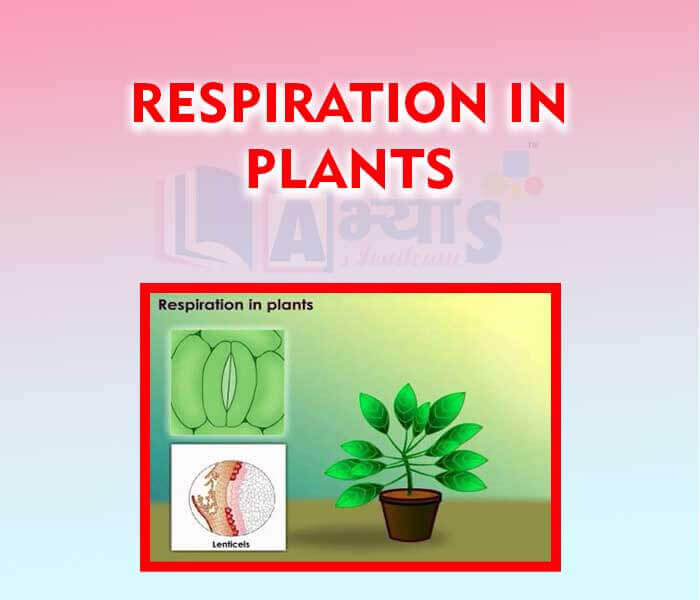Respiration In Plants





Respiration In Plants
Respiration In Plants : Plants have tiny pores called stomata found on the underside of a leaf. Air containing carbon dioxide and oxygen enters the plant through these openings where it gets used in photosynthesis and respiration. Plant that float in water, e.g. water Lily, have stomata on the upper sides of the Leaves. Underwater plants such as tape grass have no stomata. They breathe in oxygen dissolved in water through their body surfaces.
A stoma (from Greek "mouth", plural "stomata"), also called a stomate (plural "stomates") is a pore, found in the epidermis of leaves, stems, and other organs, that controls the rate of gas exchange. The pore is bordered by a pair of specialized parenchyma cells known as guard cells that are responsible for regulating the size of the stomatal opening.
The term is usually used collectively to refer to the entire stomatal complex, consisting of the paired guard cells and the pore itself, which is referred to as the stomatal aperture. Air, containing oxygen, which is used in respiration, and carbon dioxide, which is used in photosynthesis passes through stomata by gaseous diffussion. Water vapours diffuses through the stomata into the atmosphere in a process called transpiration.
Dicotyledons usually have more stomata on the lower surface of the leaves than the upper surface.
Monocotyledons such as onion, oat and maize may have about the same number of stomata on both leaf surfaces.
In plants with floating leaves, stomata may be found only on the upper epidermis and submerged leaves may lack stomata entirely.
Most tree species have stomata only on the lower leaf surface.
Size varies across species, with end-to-end lengths ranging from 10 to 80 µm. and width ranging from a few to 50 µm.
.png)
Plants have ______________ pores called stomata found on the underside of leaf. | |||
| Right Option : A | |||
| View Explanation | |||
In which of the following plants the stomata are present on the lower surface of the leaf ? | |||
| Right Option : D | |||
| View Explanation | |||
Which of the following plant have no stomata ? | |||
| Right Option : C | |||
| View Explanation | |||
Students / Parents Reviews [10]
Abhyas Methodology is very good. It is based on according to student and each child manages accordingly to its properly. Methodology has improved the abilities of students to shine them in future.

Manish Kumar
10thBeing a parent, I saw my daughter improvement in her studies by seeing a good result in all day to day compititive exam TMO, NSO, IEO etc and as well as studies. I have got a fruitful result from my daughter.

Prisha Gupta
8thMy experience with Abhyas academy is very good. I did not think that my every subject coming here will be so strong. The main thing is that the online tests had made me learn here more things.

Hiya Gupta
8thI have spent a wonderful time in Abhyas academy. It has made my reasoning more apt, English more stronger and Maths an interesting subject for me. It has given me a habbit of self studying

Yatharthi Sharma
10thA marvelous experience with Abhyas. I am glad to share that my ward has achieved more than enough at the Ambala ABHYAS centre. Years have passed on and more and more he has gained. May the centre flourish and develop day by day by the grace of God.

Archit Segal
7thAbout Abhyas metholodology the teachers are very nice and hardworking toward students.The Centre Head Mrs Anu Sethi is also a brilliant teacher.Abhyas has taught me how to overcome problems and has always taken my doubts and suppoeted me.

Shreya Shrivastava
8thAbhyas is a complete education Institute. Here extreme care is taken by teacher with the help of regular exam. Extra classes also conducted by the institute, if the student is weak.

Om Umang
10thIt has a great methodology. Students here can get analysis to their test quickly.We can learn easily through PPTs and the testing methods are good. We know that where we have to practice

Barkha Arora
10thIt was good as the experience because as we had come here we had been improved in a such envirnment created here.Extra is taught which is beneficial for future.

Eshan Arora
8thOne of the best institutes to develope a child interest in studies.Provides SST and English knowledge also unlike other institutes. Teachers are co operative and friendly online tests andPPT develope practical knowledge also.
